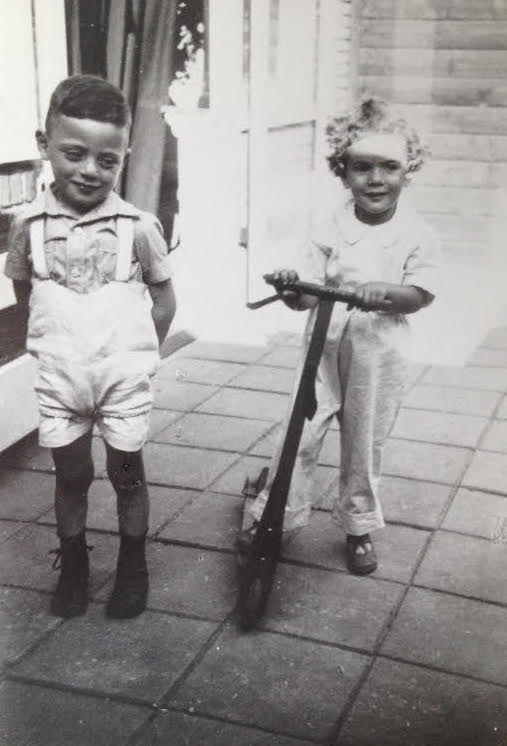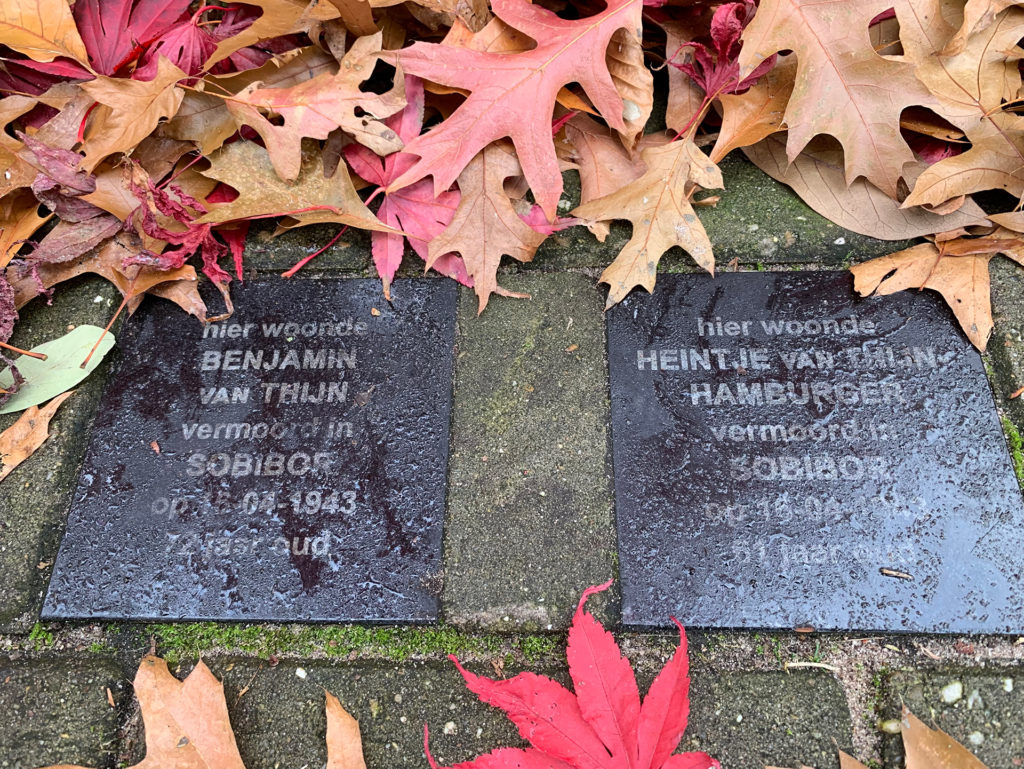Route of Commemorative Plaques
5. Voltastraat 53
This was the home of SALLI VAN OS – murdered in Auschwitz on 30/09/1942
Local children Nico Kamp and Betty Rosa van Os, 1941
Salli van Os was born in Oss in 1905. He grew up with his three sisters Rosa, Klara and Regina in the family of Alexander van Os and Elisabeth van Dijk. In August 1935, he married Betsie van Thijn and, two years later, they moved from an apartment on Geulstraat in Amsterdam to a spacious home in Voltastraat in Amersfoort. Salli worked in the office of the Erdal factory. The Erdal, founded in Amsterdam, moved to a more spacious factory site in Amersfoort, on the Eem, in 1936 and Salli probably moved with them. In 1938, his daughter Betty Rosa was born and a year later Betsie’s parents moved in with them.

Nico Kamp and Betty van Os 1941 (Photo supplied by Rolf Kamp)
‘Prohibited to Jews’
he war broke out and by 1940 Jews were already facing various measures which isolated them from the rest of the population. They were not permitted to use swimming pools, public parks, zoos, markets, hotels, cafés, theatres, cabaret and concert halls or libraries. Signs saying ‘Prohibited to Jews’ became commonplace. They were expelled from societies, had to surrender their radios and could not travel without a permit. Their opportunities to work were also increasingly limited and many Jewish employees were fired.
Systematic persecution
From 1942, the occupier took a more systematic approach to persecuting the Jews. Their identity documents bore a large, black letter ‘J’ and they had to wear a yellow star of David. Their freedom of movement was limited in almost every respect. Organised deportations started in July.
Call for departure
Salli and his family were soon called to Westerbork. On 20 August 1942, they arrived in the transition camp and the following day they departed for Auschwitz. Salli van Os was murdered on 30 September 1942 in the gas chambers of Auschwitz. He was just 36 years old. Betsie and Betty Rosa had met the same fate on 23 August.
After the war, four Jewish workers did not return to the Erdal Salli van Os was one of them. His name is engraved on a small plaque which hangs in the factory to commemorate his life. The plaque was retrieved from the property belonging to the now closed Erdal factory in 2012.
This was the home of:
BENJAMIN VAN THIJN
Murdered in Sobibor on 16/04/1943
Benjamin van Thijn had already stopped working when he and his wife moved in with his daughter Betsie and her family on Voltastraat in Amersfoort on 30 May 1939. Benjamin, born on 4 October 1870 in Zaandam to Marcus van Thijn and Paulina Stern, was probably raised in Zaandam. The Van Thijn family members in Zaandam were often butchers but Benjamin opted for another profession; he became a diamond cutter/polisher. On 14 June 1905, at the age of 34, he married Heintje Hamburger. They moved to Amsterdam and had two children: Emanuel, born in 1905 and Betsie, born in 1906.

Commemorative plaque for Benjamin van Thijn & Heintje van Thijn Hamburger
Leaving Amsterdam
At the end of the thirties, Benjamin left Amsterdam. His Amsterdam identity card then details various addresses over a short period of time. e moved from the Jekerstraat 81 in Amsterdam to the Voltastraat 53 in Amersfoort, then back to Amsterdam in 1942, and on 19 September of the same year, to Emanuel’s address at Jasper Leijnsenstraat 21. Four months later, Kerkstraat 147 in Amsterdam was given as his address on his identity card.
Leaving for Westerbork
By 1943, the systematic removal of the Jews via Westerbork and then onto the extermination camps had been going on for a year. Those who were called, had to report and anyone who did not turn up was sent to a concentration camp. Benjamin van Thijn and his wife obeyed their call for Westerbork. Their daughter Betsie and her family had already been removed. They were gassed in August 1942 in Auschwitz.
Transport to Sobibor
Benjamin and his wife reported to Westerbork on 8 April 1943. On Tuesday 13 April 1943, they were transported to Sobibor. This train, the seventh to this extermination camp, carried 1,204 men, women and children. None of them returned. Benjamin van Thijn was 72 when he was gassed on 16 April 1943 in Sobibor.











